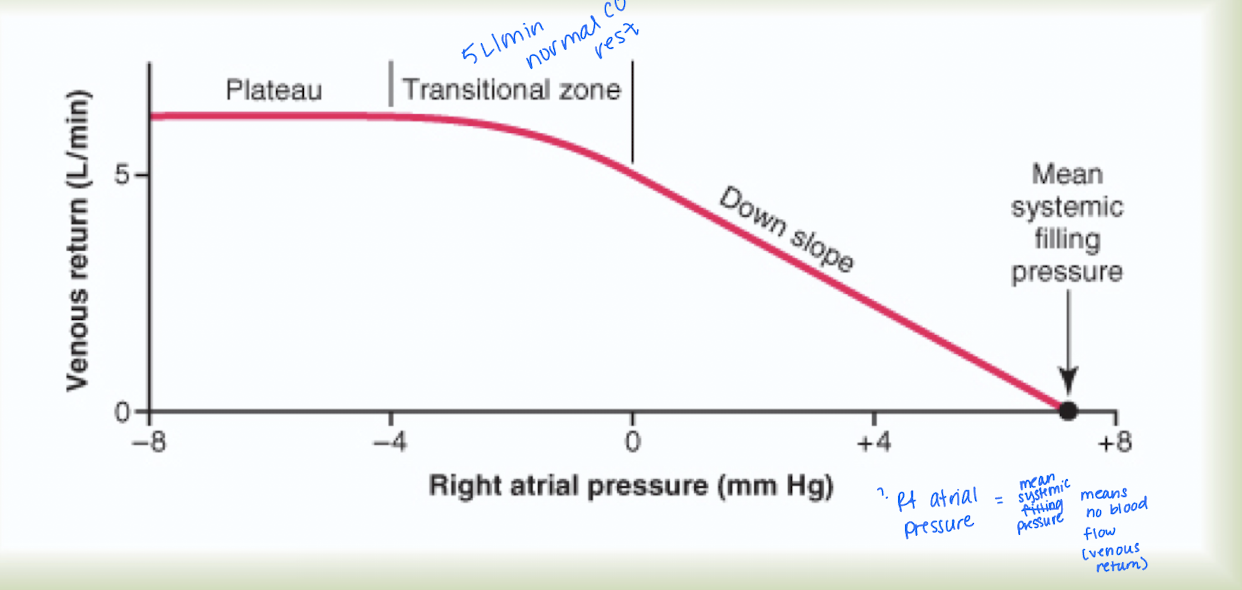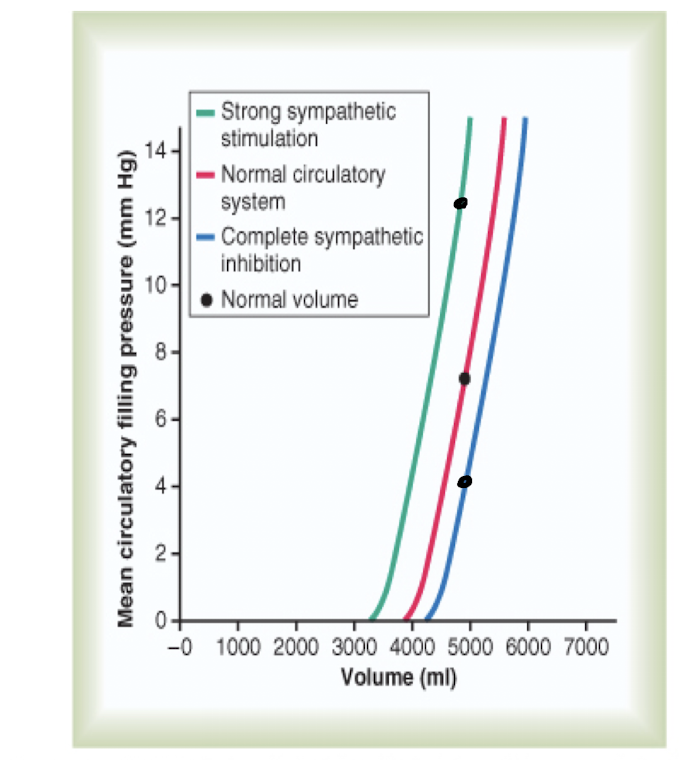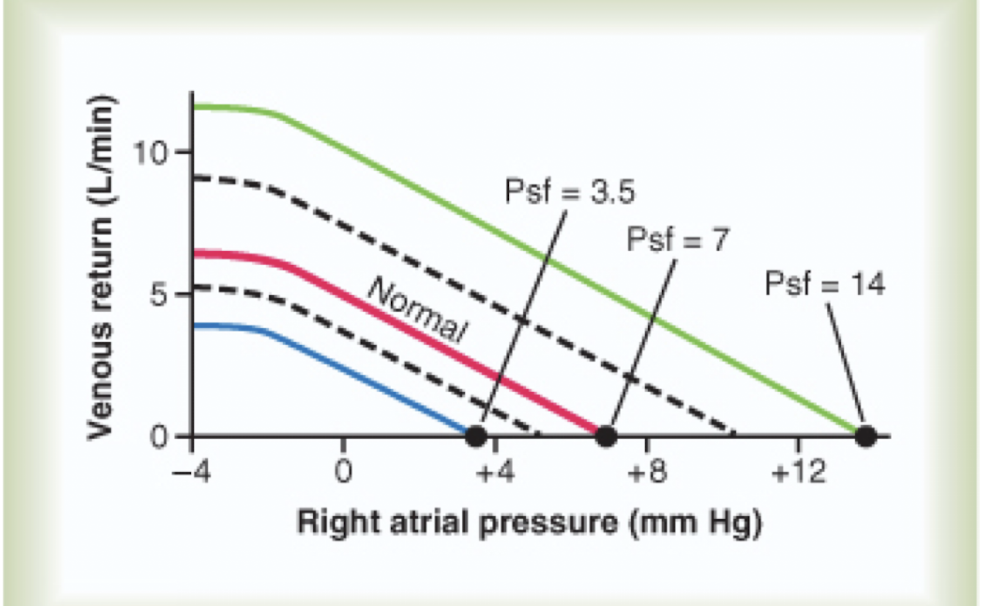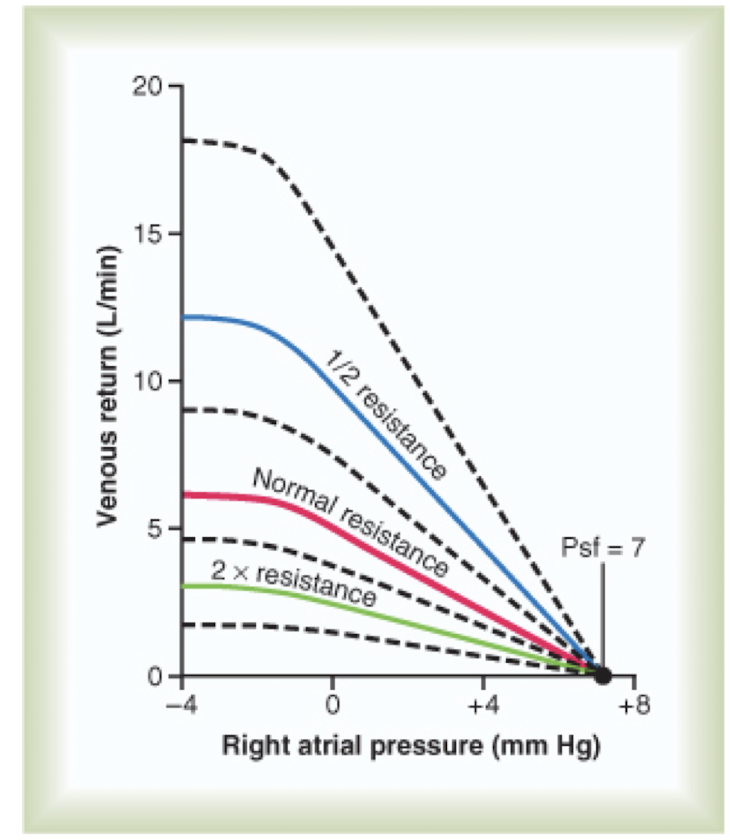Cardiac Output and Venous Return Regulation
1/23
Earn XP
Description and Tags
Flashcards reviewing the key concepts related to cardiac output, venous return, and their regulation as discussed in the lecture.
Name | Mastery | Learn | Test | Matching | Spaced |
|---|
No study sessions yet.
24 Terms
What is Cardiac Output? Why is it important? What effects it?
Sum of the blood flow to all tissues of the body; amount of blood pumped by the heart per minute
Feeds the entire body
Effected by body metabolism, exercise, age (decreases), and body size (volume)
What is Venous Return?
Blood flowing from veins to the right atrium every minute.
T/F: the heart is the primary controller of cardiac output
False, the heart only responds to the needs of the tissues
Why are the controllers of venous return (what body tissues need = peripheral factors) the controllers of cardiac output (driven by venous return)?
Frank-Starling Mechanism - preload increases stretch of ventricles increasing contractility and stroke volume
heart pumps what it sees (or has) - 5 liters of blood in, 5 liters out
What reflex is caused by the stretch of the S-A node?
Bainbridge Reflex
Increased HR due to stretch of SA node
What happens to cardiac output and oxygen consumption, as work output increases?
Cardiac output and oxygen consumption mirror one another as work output increases

Why is total peripheral resistance important?
What is it’s relationship cardiac output?
Brings blood back to the heart
Inverse relationship (CO = arterial pressure / TPR)
How does long-term cardiac output vary with changes in Total Peripheral Resistance (TPR)?
Long-term cardiac output varies reciprocally with changes in TPR

Looking at the graph’s relationship between total peripheral pressure and cardiac output (atrial), what can be described?
Normal cardiac output is acquired at 100 percent TPR
As TPR decreases, cardiac output increases creating conditions such as Paaget’s disease, Pulmonary disease, Anemia, hyperthyroidism, AV shunts, and Beriberi
As TPR increases, cardiac output decreases and conditions arise such as hypothyroidism and amputation due to poor blood flow
What happens to a normal functioning heart before it becomes a limiting factor in cardiac output?
A normal functioning heart can pump a Venous Return (VR) of 2.5x normal till cardiac output plateus
What are the causes of a hypereffective heart?
Nervous stimulation
sympathetic stimulation or parasympathetic inhibition
increase HR (increasing VR and CO) and strength of contraction
Hypertrophy of the cardiac muscle
Increase in mass and contractile strength which increases L ventricle muscle mass
What are the causes of a hypoeffective (heart that doesn’t pump blood effectively) heart?
Increased arterial pressure (hypertension) - increased workload on the heart, left ventricular hypertrophy, and diastolic dysfunction. Over time, the heart's muscles thicken and become stiffer, making it harder to pump blood efficiently.
Inhibition of nervous excitation
Abnormal heart rhythm
Coronary blockage
Valvular disease - blood flow is not optimal
Cardiac hypoxia
Dinitrophenol is a drug that vasodilates, decreasing arterial pressure and allowing venous return. How does the nervous system help maintain arterial BP to achieve optimal CO?
Peripheral dilation to increase venous return (VR) and counterbalance the effects of dinitrophenol, thus helping to stabilize arterial blood pressure (BP) and maintain optimal cardiac output (CO).
How does the nervous system compensate for the normal decrease in TPR (vasodilation) during exercise because it decreases arterial pressure?
Nervous system will send signals to constrict large veins, increase heart rate, and increase contractility. Nervous system will raise arterial pressure above normal (occurs in exercise)
T/F: In exercise it is normal for diastolic pressure to increase.
False - don’t want an increase because it means there is greater resistance as blood is trying to travel back to the heart
What are the 3 principal factors that affect venous return to the heart from the periphery?
Right atrial pressure - exerts backward force on veins
Mean systemic filling pressure - pressure in system circulation when all blood flow is stopped
Resistance to blood flow - occurs between peripheral vessels and Rt atrium

What can be inferred by the graph?
As right atrial pressure increases, venous return will decrease.
Mean systemic filling pressure is reached at 7 mm Hg right arterial pressure and venous return is 0 (equilibrium)
How is venous return related to right atrial pressure if all nervous circulatory reflexes are prevented from acting?
Venous return decreases to zero when the right atrial pressure rises to +7 mm Hg.
Venous and Arterial pressures come to equilibrium when all flow in systemic circulation ceases at +7 mmHg
mean systemic filling pressure (Psf)

Mean Circulatory Filling Pressure (MCFP) vs Mean Systemic Filling Pressure (MSFP)
MCFP
average pressure in the entire circulatory system when the heart is stopped and blood flow ceased allowing pressure to equalize in the system
MSFP
only considers the systemic circulation, excluding pulmonary circuit if the heart stopped and blood flow halted
venous return is driven by the pressure gradient b/t MSFP and right atrial pressure
*looking at the graph, RAP standard is 0 mmHg

How is the pressure gradient for venous return calculated?
Difference between the Mean Systemic Filling Pressure (MSFP) and the right atrial pressure.
The greater the gradient, the greater the venous return making it easier for blood to flow back to the heart
Describe how resistance return affects venous return comparing veins and arteries
Veins
veins are highly distensible (stretchable)
when resistance in the veins increases, blood will back up into the venous system and pressure will rise only slightly because they are distensible = veins have greater capacitance (hold more blood) without significant rise in pressure
the small pressure increase is not enough to push blood past the resistance and back to the heart resulting in less blood returns to the heart lowering cardiac output
On the Arterial side, when resistance increases, blood accumulates in the arteries and arteries are less compliant (rigid) so pressure increases significantly when blood accumulates
Arteries have reduced capacitance
so when resistance increases, pressure builds, helping push blood forward past the resistance
How do you calculate venous return?
VR = Psf - PRA (Right arterial pressure) / RVR (resistance to venous return)
VR = 5 L/min
Psf = 7 mm Hg
PRA = 0 mmHg
*RVR and PRA have positive relationship

An increase in cardiac output due to increased blood volume only lasts for a few minutes due to compensatory effects which occur immediately - what are they?
Increased capillary pressure pushes fluid into the tissues decreasing pressure
Veins continue to distend due to increase pressure causing blood to pool in reservoirs (liver and spleen)
Increased blood flow through tissues causes autoregulatory response to increase peripheral vascular resistance
Describe the effect of sympathetic stimulation on Cardiac output
Sympathetic stimulation increases cardiac output by increasing heart rate and contractility. It enhances the force of each heartbeat, thereby increasing stroke volume and overall blood flow to meet the body's demands.
Graph:
when right atrial pressure is 0 and conditions are normal, CO is 5-6 L/min
When moderate sympapthetic stimulation is applied, CO increases
Same when maximal sympathetic stimulation is applied
